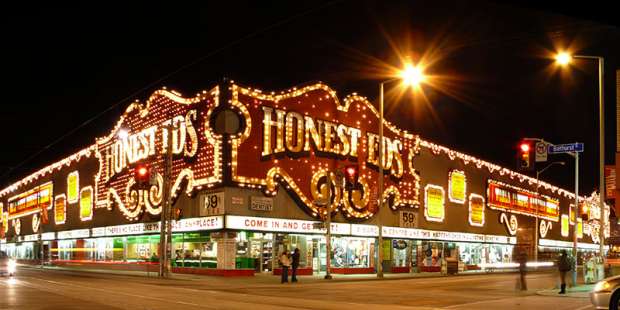By Victoria Quiroz
Monday, Mar. 10 marked Honest Ed’s slow march towards the Toronto deadpool.
At 11 a.m. the store’s iconic hand-painted signs went up for auction, allowing Torontonians to get their hands on a piece of the city’s history.
In July of last year, it was announced the Toronto landmark had been put up for sale. The discount department store, a goliath of marquee lights and neon, has stood at the corner of Bathurst and Bloor since opening in 1948.
Following a $100 million deal with Vancouver-based luxury developer Westbank, David Mirvish (son of Ed “Honest Ed” Mirvish) now rents the 1.8-hectare property. Mirvish previously stated he will continue to rent the property for the next two to three years, as Westbank decides what to do with the land.
Honest Ed’s closure and eventual demolition is a ways away but it places it amongst some of Toronto’s historic landmarks that have either faced the wrecking ball, renovations or soon will.
The El Mocambo, a legendary Toronto rock club, went on the market late last week. With a price tag of $3.95-million, its Royal LePage listing suggests the location would be ideal for “student housing, fitness club, boutique hotel, etc.”
Since opening in 1948, the El Mocambo has hosted a slew of globally famous acts, particularly in its 1970’s heyday. These acts ranged from Blondie to the Ramones, from U2 to the Rolling Stones.
Neil Warshafsky, broker for the El Mocambo’s sale, has been working to find buyers who will keep the property a music venue.
“I personally think it’s 50/50, based upon the interest it’s accumulated,” said Warshafsky.
This isn’t the first time the El Mocambo has changed ownership. It’s been sold an estimated 10 times, most recently in 2012 to Cadillac Lounge owner, Sam Grosso and his business partner Marco Petrucci.
Warshafsky said the building has gone up for sale following a decision by Grosso and Petrucci, who appear to be going in different directions.
“Times change, concepts come and go,” said Warshafsky, who used to go to the El Mocambo as a kid. “I’d like to keep it exactly as it is.”
But in a city with an apparently innumerable amount of “cranes in the air,” many buildings are bound to fall by the wayside, landmarks or not.
Below is an interactive map compiling many of Toronto’s long-gone, almost-gone and could-be-gone landmarks.

